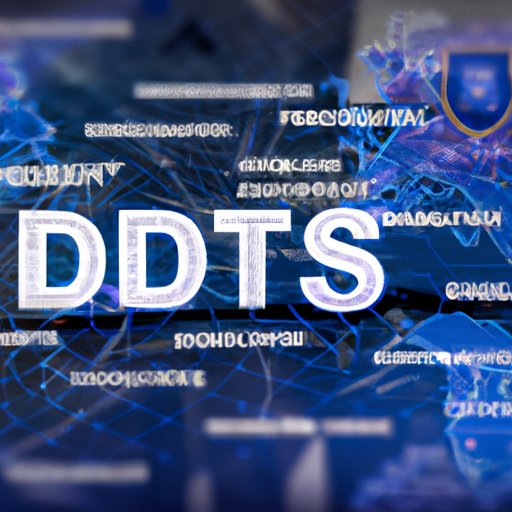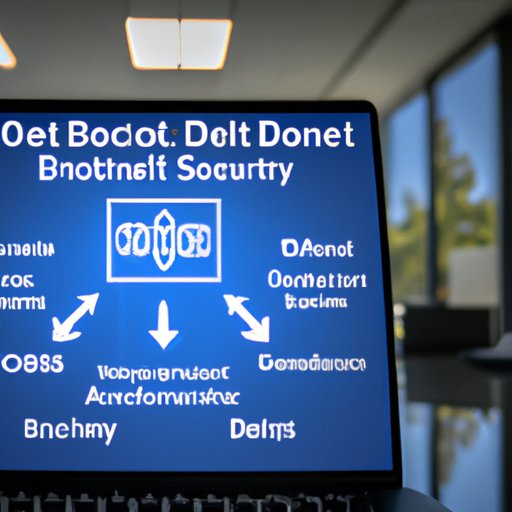Introduction
The Department of Defense (DOD) is responsible for protecting the nation from threats both at home and abroad. In recent years, the DOD has placed an increased emphasis on cybersecurity, as cyber threats become increasingly sophisticated and widespread. This article will explore what is DOD cybersecurity, its role in national security, policies and practices, challenges, benefits, latest developments, and its impact on U.S. and global security.

Exploring the Role of DOD Cybersecurity in National Security
The DOD plays a critical role in protecting the nation’s infrastructure, assets, and citizens from cyber threats. The DOD has established a number of policies and procedures to ensure that it can effectively respond to cyber threats and protect the nation.
Defining the Role of DOD Cybersecurity
The DOD’s primary goal is to protect the nation against cyber threats. To achieve this goal, the DOD has developed a comprehensive approach to cybersecurity. This approach includes a range of activities, including identifying and analyzing potential threats, developing defensive strategies and capabilities, and responding to incidents. The DOD also works closely with other federal agencies and private sector partners to share information and coordinate responses.
The Impact of DOD Cybersecurity on National Security
By taking a proactive approach to cybersecurity, the DOD is able to prevent, detect, and respond to cyber threats. This helps to ensure that the nation’s networks, systems, and data remain secure and protected. Additionally, by working closely with other agencies and partners, the DOD is better positioned to identify and respond to emerging threats. This helps to reduce the risk of large-scale cyberattacks, which could have devastating consequences for the nation.
An Overview of DOD Cybersecurity Policies and Practices
The DOD has established a number of policies and procedures to ensure that it can effectively respond to cyber threats. These policies and procedures are designed to strengthen the nation’s cybersecurity posture and reduce the risk of attacks.
Overview of DOD Cybersecurity Policies
The DOD has established a number of policies to help protect the nation from cyber threats. These policies include:
- The DOD Instruction 8500.01, which outlines the DOD’s policy for protecting information systems.
- The DOD Directive 8510.01, which outlines the DOD’s strategy for defending against cyber threats.
- The DOD Directive 8140.01, which outlines the DOD’s policy for training and certifying personnel who handle sensitive information.
- The DOD Directive 8551.01, which outlines the DOD’s policy for establishing and maintaining secure networks.
- The DOD Directive 8530.01, which outlines the DOD’s policy for responding to cyber incidents.
These policies provide the framework for the DOD’s cybersecurity efforts.
Overview of DOD Cybersecurity Practices
In addition to the policies outlined above, the DOD has established a number of practices to help protect the nation from cyber threats. These practices include:
- Implementing robust authentication measures.
- Encrypting sensitive data.
- Conducting regular vulnerability assessments.
- Monitoring networks for suspicious activity.
- Enforcing strict access controls.
- Developing response plans for cyber incidents.
By implementing these practices, the DOD is better positioned to detect, respond to, and mitigate cyber threats.
Examining the Challenges of DOD Cybersecurity
Despite the DOD’s best efforts, there are still a number of challenges associated with protecting the nation from cyber threats. These challenges include:
Defining the Challenges of DOD Cybersecurity
The challenges associated with protecting the nation from cyber threats include:
- Limited resources: The DOD has limited resources available to dedicate to cybersecurity, making it difficult to keep up with the ever-evolving threat landscape.
- Lack of collaboration: The DOD often lacks the ability to collaborate effectively with other agencies and partners, making it difficult to share information and coordinate responses.
- Outdated technology: The DOD is often slow to adopt new technologies, making it difficult to stay ahead of the curve when it comes to cyber threats.
- Insider threats: The DOD is vulnerable to insider threats, such as employees or contractors who may use their access to maliciously harm the organization.
These challenges make it difficult for the DOD to effectively protect the nation from cyber threats.
Analyzing How to Overcome the Challenges of DOD Cybersecurity
Despite the challenges outlined above, there are a number of steps the DOD can take to improve its cybersecurity posture. These steps include:
- Increasing resources: The DOD should prioritize increasing its resources dedicated to cybersecurity, including personnel and technology.
- Improving collaboration: The DOD should strive to improve its collaboration with other agencies and partners, in order to share information and coordinate responses.
- Adopting new technology: The DOD should prioritize adopting new technologies, such as artificial intelligence and machine learning, in order to stay ahead of the curve.
- Mitigating insider threats: The DOD should implement robust measures to mitigate insider threats, including conducting background checks and monitoring employee behavior.
By taking these steps, the DOD can better protect the nation from cyber threats.

Analyzing the Impact of DOD Cybersecurity on U.S. and Global Security
The DOD’s cybersecurity efforts have a significant impact on U.S. and global security. These impacts can be both positive and negative.
The Positive Effects of DOD Cybersecurity on U.S. and Global Security
The DOD’s cybersecurity efforts have a number of positive effects on U.S. and global security. These effects include:
- Reduced risk of attacks: By taking a proactive approach to cybersecurity, the DOD is able to reduce the risk of cyberattacks, which could have devastating consequences for the nation.
- Improved collaboration: By working closely with other agencies and partners, the DOD is better positioned to identify and respond to emerging threats.
- Increased trust: By demonstrating its commitment to cybersecurity, the DOD can build trust among its partners and allies, which can help to strengthen relationships and foster cooperation.
These positive effects help to ensure that the nation remains secure and protected.
The Negative Effects of DOD Cybersecurity on U.S. and Global Security
The DOD’s cybersecurity efforts can also have a number of negative effects on U.S. and global security. These effects include:
- Restrictions on freedom: The DOD’s cybersecurity policies and procedures can place restrictions on freedom, such as limiting access to certain websites or services.
- Increased surveillance: The DOD’s cybersecurity efforts may lead to increased surveillance of citizens, which can infringe on privacy rights.
- Misuse of power: The DOD’s cybersecurity efforts may lead to the misuse of power, such as using surveillance to target political opponents.
These negative effects can have a detrimental impact on U.S. and global security.

A Look at the Benefits of DOD Cybersecurity for Businesses
The DOD’s cybersecurity efforts can also have a number of benefits for businesses. These benefits include:
- Improved security posture: By leveraging the DOD’s cybersecurity policies and practices, businesses can improve their security posture and better protect their networks, systems, and data.
- Enhanced collaboration: By collaborating with the DOD, businesses can gain access to expertise and resources that can help them better protect their networks and systems.
- Reduced costs: By leveraging the DOD’s cybersecurity efforts, businesses can reduce their costs associated with cybersecurity, such as hiring personnel or purchasing technology.
These benefits can help businesses better protect their networks and systems.
Highlighting the Latest Developments in DOD Cybersecurity
The DOD is continuously innovating and adapting its cybersecurity efforts to better protect the nation. As part of this effort, the DOD has recently implemented a number of initiatives, including:
- The Cybersecurity Maturity Model Certification (CMMC): The CMMC is a new certification program designed to help organizations assess and improve their cybersecurity posture.
- The Joint Cybersecurity Coordination Group (JCCG): The JCCG is a new interagency group designed to coordinate the DOD’s cybersecurity efforts with other federal agencies.
- The Cybersecurity Directorate: The Cybersecurity Directorate is a new organization within the DOD designed to oversee the department’s cybersecurity efforts.
These initiatives demonstrate the DOD’s commitment to protecting the nation from cyber threats.
How the Latest Developments in DOD Cybersecurity Affect Businesses
The latest developments in DOD cybersecurity can have a significant impact on businesses. For example, businesses that work with the DOD may be required to comply with the CMMC in order to do business with the government. Additionally, businesses may be required to collaborate with the JCCG in order to share information and coordinate responses. Finally, businesses may be affected by the Cybersecurity Directorate’s policies and procedures. By understanding how the latest developments in DOD cybersecurity affect their organization, businesses can better prepare for the future.
Conclusion
The DOD plays a critical role in protecting the nation from cyber threats. To achieve this goal, the DOD has established a comprehensive approach to cybersecurity, including a range of policies and practices. Despite the DOD’s best efforts, there are still a number of challenges associated with protecting the nation from cyber threats. These challenges can be overcome by increasing resources, improving collaboration, adopting new technology, and mitigating insider threats. The DOD’s cybersecurity efforts have a significant impact on U.S. and global security, both positive and negative. The DOD’s cybersecurity efforts also have a number of benefits for businesses, including improved security posture, enhanced collaboration, and reduced costs. Finally, the DOD is continuously innovating and adapting its cybersecurity efforts to better protect the nation, which can have a significant impact on businesses.
In conclusion, the DOD plays a critical role in protecting the nation from cyber threats. By understanding the role of DOD cybersecurity, its policies and practices, challenges, benefits, and latest developments, businesses can better prepare for the future and protect their networks and systems.
(Note: Is this article not meeting your expectations? Do you have knowledge or insights to share? Unlock new opportunities and expand your reach by joining our authors team. Click Registration to join us and share your expertise with our readers.)
